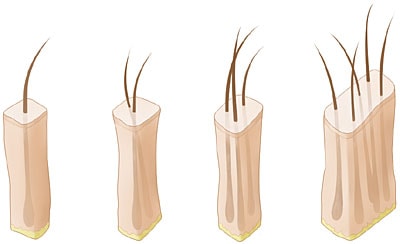
A. The best hair transplant doctors now strive for completely natural looking hairline – not the uniform neat rows of a few years ago. You should be able to style your hair in a way that flatters your face and takes advantage of your hair’s color, curl, texture and direction.
You may even comb it straight back if you like, however keep in mind that transplanted hair will be thinner than your original hair.
A. For centuries, men have rubbed peculiar substances into their scalp, ate all sorts of “miracle” cures, and subjected themselves to electrical stimulation – all with the hope of growing hair.
Medications such as minoxidil, or Rogaine, is promising, although its use is of a limited scope. It grow hair under certain conditions and the growth is sustained as long as the person continues the applications. Also the hair growth that it stimulates is short vellus hair – which is short, fuzzy hair that frequently precedes complete baldness. Finasteride, or Propecia, has been shown to slow down hair loss, and in some individuals, even stimulate hair growth. However, similar with minoxidil, if the medication is stopped, the beneficial effects of finasteride diminish significantly. Your doctor will consider medication in an overall program for hair restoration. Read more about available medications here.
A. Introduction of Follicular Transplantation and the use of the binocular microscope can increase the growth of transplanted hair up to 20%. Hair grows naturally in groups of 1-4 hairs in each pore. These are called follicular bundles or follicular groups and can be seen with the unaided eye by closely examining the scalp.

There you will see naturally occurring, 1-4 hairs coming from each pore. If this bundle or group of hair is undisturbed during hair transplantation, it will grow much better that if it is damaged or cut. Use of the binocular microscope in dissecting grafts allows technicians to microscopically examine and dissect each bundle without damage. The work is much more precise, more difficult and more time consuming. Whereas the procedure used to take 2 to 3 hours, now it may take up to 6 or 7 hours and requires many more technicians.

Because of the increase in technicians, quality control is essential. There are certain checkpoints during the procedure to ensure perfect graft and precise gentle planting of each graft. Routine and random checks are made of the graft during microscopic dissection and during microscopic planting. There is not more precise method of graft preparation.
A. Although individual pain threshold vary, transplant patient generally express surprise at the small amount of discomfort associated with Follicular Unit Transplant (FUT) and Follicular Unit Extraction (FUE) hair transplantation. The client is given a relaxing medication, which actually makes the experience almost enjoyable in many cases.
A. The vast majority of clients leave the clinic, after Follicular Unit Transplant (FUT) or Follicular Unit Extraction (FUE) surgery, without a bandage. Sometimes a baseball cap is used to hide the area that has been worked on. Occasionally, there is some redness and swelling for a few days, but it is normally not very visible. If you have enough pre-existing hair, you will be able to comb that hair over the transplants to hide them. Your newly transplanted hair will grow in over several months. See the hair transplant growth timeline here.
A. In general, transplanted hair, either with Follicular Unit Transplant (FUT) or Follicular Unit Extraction (FUE) techniques, requires between 4 and 6 months to start growing. You should wait at least that long before returning for additional sessions. Hair transplant used to be a lifetime commitment because the transplant would eventually become obvious as the remaining hair gradually fell out.
Now however, most men are not committed to return. Our doctors' design for follicular transplants looks perfectly natural even as baldness progresses over the years. That is not to say that most clients do not return for more sessions. Most are so pleased with the results that they do return from time to time to our doctors to increase the density of their transplanted hair.
A. The number of grafts that can be transplanted per session, either by Follicular Unit Transplant (FUT) or Follicular Unit Extraction (FUE), is dependent upon a certain number of factors and it is determined after accurate evaluation during the consultation by one of our doctors in Korea. Also, hair loss patterns are different between men and women, and your doctor will tailor your hair transplant to your particular situation. Read more about hair loss in men and hair loss in women.
The key factors are: (1) the size of the bald area, (2) the color of the hair, (3) the density of the hair, (4) texture, (5) curl of the hair, (6) size of the graft, and (7) the goals and expectations of the client.

A. When you have a personal consultation with one of our Korea-based doctors, he will evaluate the nature and extent of your baldness pattern, the potential of your remaining hair to yield healthy donor grafts and the like hood of future hair loss. You can be assured that you will obtain an honest opinion here. If he feels that you are a poor candidate (perhaps too young, have too much existing hair or even too bald) you will be told outright. Contact us now to have a consultation with one of our doctors, who will give you advice on the best way to proceed.

Please send us your email address, and one of our representatives will personally contact you as soon as possible.
Your email address will never be sold or spammed.